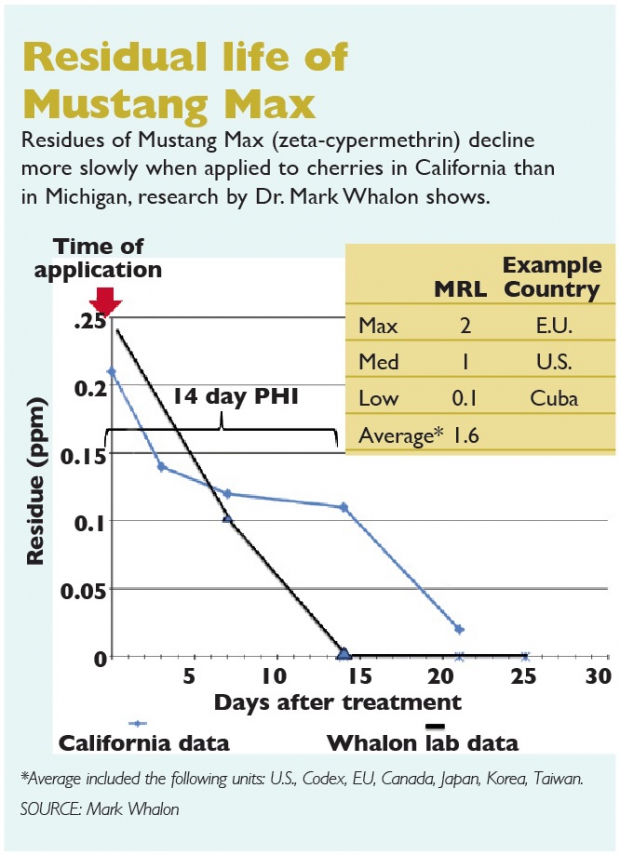New invasive insect pests, such as spotted wing drosophila and brown marmorated stinkbug, are strongly attracted to ripening fruit, and strike orchards very near to harvest.
This means growers have to apply sprays in the late season when they are more likely to leave pesticide residues on fruit.
At the same time that the need to spray close to harvest is increasing, consumers—and government regulators—are looking at pesticide residues ever more warily.
When fruit growers spray an orchard with a pesticide, what’s the risk that they may be tripped up later by an illegal level of residue?
What are the chances a load of fruit will be rejected at some point, and they will incur costs of rejected fruit or other penalties?
Dr. Mark Whalon, a Michigan State University entomologist, embarked on a project last year that will result, he hopes, in a useful tool for growers. He wants to create probability charts showing the risk of exceeding a Maximum Residue Limit (MRL) with any given insecticide and some disease control materials, too. What can I spray today? Check the chart.
Last year, technicians at Whalon’s lab studied five insecticides—in four different classes—to see how long it took for residue levels to fall below an acceptable maximum residue level. The levels were chosen to conform to the demands of different countries that might be final markets for the fruit. Maximum residue levels are not uniform around the world.
“We studied the worst first,” Whalon said. By worst he means insecticides that would be applied close to harvest to kill insects such as spotted wing drosophila or obliquebanded leafroller. Leafrollers are a special problem in tart cherries because their larvae can fall into a shaker-harvested tank of cherries. The tolerance for worms in processed tart cherries is zero.
Test trees were sprayed at different rates and different dates relative to harvest, and fruit was harvested, frozen, and sampled for residues at 7, 14, and 21 days after harvest. This year, he hopes to study different methods of handling harvested fruit. Tart cherries, for example, are handled in tanks of cold water, and water degrades many pesticides.
“One of the reasons we always liked Guthion
The results—just one year’s data collected from samples from three-tree treatments replicated three times—were charted on graphs. When similar studies were available, the chart included data from two arid growing regions in the West.
The researchers found the breakdown patterns can be quite different in dry growing areas than in the wetter areas of the East. “Many times, fruit in dry climates retains residues longer than fruit in wet climates,” he said.
Insecticides
The insecticides that were studied included:
—Assail (acetamiprid): A neonicotinoid insecticide, which broke down relatively quickly and presented few MRL issues.
—Delegate (spinetoram): A spinosyn insecticide, which also broke down quickly.
—Imidan (phosmet): An organophosphate insecticide, it initially broke down steadily, but the degradation slowed and residues persisted above the low maximum residue levels required in some markets. “I want to really caution you about using this product close to harvest,” Whalon said. “And definitely do not send this fruit to Japan.”
—Mustang Max (zeta-cypermethrin): A pyrethroid insecticide that also showed a lag in the final breakdown phase, typical of some synthetic pyrethroids, Whalon said. Again, use should depend on the maximum residue level in the recipient country.
—Danitol (fenpropathrin): This pyrethroid showed a very long decay pattern that could trigger an maximum residue level problem if the material was used too close to harvest.
Whalon’s lab has funding now to continue to develop these profiles on more insecticides during the coming year. •







Leave A Comment